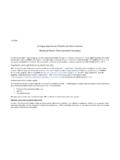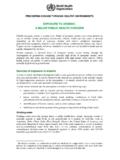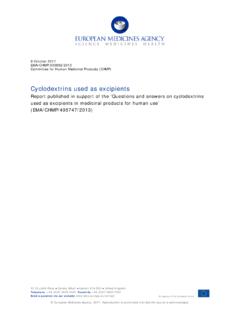Transcription of Clinical Practice Guideline for the Use of Antimicrobial ...
1 IDSA GUIDELINES. Clinical Practice Guideline for the Use of Downloaded from by Shiffman Medical Library, Wayne State University user on 06 December 2018. Antimicrobial Agents in Neutropenic Patients with Cancer: 2010 Update by the Infectious Diseases Society of America Alison G. Freifeld,1 Eric J. Bow,9 Kent A. Sepkowitz,2 Michael J. Boeckh,4 James I. Ito,5 Craig A. Mullen,3 Issam I. Raad,6. Kenneth V. Rolston,6 Jo-Anne H. Young,7 and John R. Wingard8. 1 Department of Medicine, University of Nebraska Medical Center, Omaha, Nebraska; 2 Department of Medicine, Memorial Sloan-Kettering Cancer Center, New York; 3 Department of Pediatrics, University of Rochester Medical Center, Rochester, New York; 4 Vaccine and Infectious Disease Division, Fred Hutchinson Cancer Research, Seattle, Washington; 5 Division of Infectious Diseases, City of Hope National Medical Center, Duarte, California;. 6 Department of Infectious Diseases, Infection Control and Employee Health, The University of Texas Anderson Cancer Center, Houston, Texas.
2 7 Department of Medicine, University of Minnesota, Minneapolis, Minnesota; 8 Division of Hematology/Oncology, University of Florida, Gainesville, Florida; and 9 Departments of Medical Microbiology and Internal Medicine, the University of Manitoba, and Infection Control Services, Cancer Care Manitoba, Winnipeg, Manitoba, Canada This document updates and expands the initial Infectious Diseases Society of America (IDSA) Fever and Neutropenia Guideline that was published in 1997 and first updated in 2002. It is intended as a guide for the use of Antimicrobial agents in managing patients with cancer who experience chemotherapy-induced fever and neutropenia. Recent advances in Antimicrobial drug development and technology, Clinical trial results, and extensive Clinical experience have informed the approaches and recommendations herein. Because the previous iteration of this Guideline in 2002, we have a developed a clearer definition of which populations of patients with cancer may benefit most from antibiotic, antifungal , and antiviral prophylaxis.
3 Furthermore, categorizing neutropenic patients as being at high risk or low risk for infection according to presenting signs and symptoms, underlying cancer, type of therapy, and medical comorbidities has become essential to the treatment algorithm. Risk stratification is a recommended starting point for managing patients with fever and neutropenia. In addition, earlier detection of invasive fungal infections has led to debate regarding optimal use of empirical or preemptive antifungal therapy, although algorithms are still evolving. What has not changed is the indication for immediate empirical antibiotic therapy. It remains true that all patients who present with fever and neutropenia should be treated swiftly and broadly with antibiotics to treat both gram-positive and gram-negative pathogens. Finally, we note that all Panel members are from institutions in the United States or Canada; thus, these guidelines were developed in the context of North American practices. Some recommendations may not be as applicable outside of North America, in areas where differences in available antibiotics, in the predominant pathogens, and/or in health care associated economic conditions exist.
4 Regardless of venue, Clinical vigilance and immediate treatment are the universal keys to managing neutropenic patients with fever and/or infection. EXECUTIVE SUMMARY. Fever during chemotherapy-induced neutropenia may be the only indication of a severe underlying infection, Received 29 October 2010; accepted 17 November 2010. because signs and symptoms of inflammation typically Correspondence: Alison G. Freifeld, MD, Immunocompromised Host Program, Dept of Medicine, University of Nebraska Medical Center, Omaha, NE 68198-5400 are attenuated. Physicians must be keenly aware of the infection risks, diagnostic methods, and Antimicrobial Clinical Infectious Diseases 2011;52(4):e56 e93 therapies required for management of febrile patients The Author 2011. Published by Oxford University Press on behalf of the Infectious Diseases Society of America. All rights reserved. For Permissions, through the neutropenic period. Accordingly, algorith- please mic approaches to fever and neutropenia, infection 1058-4838/2011/524-0001$ DOI: prophylaxis, diagnosis, and treatment have been e56 d CID 2011:52 (15 February) d Freifeld et al established during the past 40 years, guided and modified by urea nitrogen; and measurement of electrolytes, hepatic Clinical evidence and experience over time.
5 Transaminase enzymes, and total bilirubin (A-III). The Infectious Diseases Society of America Fever and Neu- 6. At least 2 sets of blood cultures are recommended, with a tropenia Guideline aims to provide a rational summation of set collected simultaneously from each lumen of an existing these evolving algorithms. Summarized below are the recom- central venous catheter (CVC), if present, and from mendations made in the 2010 Guideline update. A detailed a peripheral vein site; 2 blood culture sets from separate Downloaded from by Shiffman Medical Library, Wayne State University user on 06 December 2018. description of the methods, background, and evidence sum- venipunctures should be sent if no central catheter is present maries that support each of the recommendations can be found (A-III). Blood culture volumes should be limited to ,1% of in the full text of the Guideline . total blood volume (usually 70 mL/kg) in patients weighing ,40 kg (C-III). Guideline RECOMMENDATIONS FOR THE 7.
6 Culture specimens from other sites of suspected infection EVALUATION AND TREATMENT OF PATIENTS should be obtained as clinically indicated (A-III). WITH FEVER AND NEUTROPENIA 8. A chest radiograph is indicated for patients with respiratory signs or symptoms (A-III). I. What Is the Role of Risk Assessment and What Distinguishes High-risk and Low-risk Patients with Fever and Neutropenia? III. In Febrile Patients With Neutropenia, What Empiric Recommendations Antibiotic Therapy Is Appropriate and in What Venue? Recommendations 1. Assessment of risk for complications of severe infection General Considerations should be undertaken at presentation of fever (A-II). Risk assessment may determine the type of empirical antibiotic 9. High-risk patients require hospitalization for IV. therapy (oral vs intravenous [IV]), venue of treatment (inpatient empirical antibiotic therapy; monotherapy with an anti- vs outpatient), and duration of antibiotic therapy (A-II). pseudomonal b-lactam agent , such as cefepime, a 2.
7 Most experts consider high-risk patients to be those with carbapenem (meropenem or imipenem-cilastatin), or anticipated prolonged (.7 days duration) and profound piperacillin-tazobactam, is recommended (A-I). Other neutropenia (absolute neutrophil count [ANC] <100 cells/ antimicrobials (aminoglycosides, fluoroquinolones, and/or mm3 following cytotoxic chemotherapy) and/or significant vancomycin) may be added to the initial regimen for medical co-morbid conditions, including hypotension, management of complications (eg, hypotension and pneumonia, new-onset abdominal pain, or neurologic changes. pneumonia) or if Antimicrobial resistance is suspected or Such patients should be initially admitted to the hospital for proven (B-III). empirical therapy (A-II). 10. Vancomycin (or other agents active against aerobic gram- 3. Low-risk patients, including those with anticipated brief positive cocci) is not recommended as a standard part of the (<7 days duration) neutropenic periods or no or few co- initial antibiotic regimen for fever and neutropenia (A-I).
8 These morbidities, are candidates for oral empirical therapy (A-II). agents should be considered for specific Clinical indications, 4. Formal risk classification may be performed using the including suspected catheter-related infection, skin or soft-tissue Multinational Association for Supportive Care in Cancer infection, pneumonia, or hemodynamic instability. (MASCC) scoring system (B-I). 11. Modifications to initial empirical therapy may be considered for patients at risk for infection with the following i. High-risk patients have a MASCC score ,21 (B-I). All antibiotic-resistant organisms, particularly if the patient's patients at high risk by MASCC or by Clinical criteria should condition is unstable or if the patient has positive blood be initially admitted to the hospital for empirical antibiotic culture results suspicious for resistant bacteria (B-III). These therapy if they are not already inpatients (B-I). include methicillin-resistant Staphylococcus aureus (MRSA), ii. Low-risk patients have a MASCC score >21 (B-I).
9 Carefully vancomycin-resistant enterococcus (VRE), extended-spectrum selected low-risk patients may be candidates for oral and/or b-lactamase (ESBL) producing gram-negative bacteria, and outpatient empirical antibiotic therapy (B-I). carbapenemase-producing organisms, including Klebsiella pneumoniae carbapenemase (KPC). Risk factors include II. What Specific Tests and Cultures Should be Performed during previous infection or colonization with the organism and the Initial Assessment? treatment in a hospital with high rates of endemicity. Recommendations i. MRSA: Consider early addition of vancomycin, linezolid, or 5. Laboratory tests should include a complete blood cell daptomycin (B-III). (CBC) count with differential leukocyte count and platelet ii. VRE: Consider early addition of linezolid or daptomycin count; measurement of serum levels of creatinine and blood (B-III). Clinical Practice Guideline d CID 2011:52 (15 February) d e57. iii. ESBLs: Consider early use of a carbapenem (B-III).
10 I. An IV-to-oral switch in antibiotic regimen may be made if iv. KPCs: Consider early use of polymyxin-colistin or patients are clinically stable and gastrointestinal absorption is tigecycline (C-III). felt to be adequate (A-I). ii. Selected hospitalized patients who meet criteria for being at 12. Most penicillin-allergic patients tolerate cephalosporins, low risk may be transitioned to the outpatient setting to receive but those with a history of an immediate-type hypersensitivity either IV or oral antibiotics, as long as adequate daily follow-up Downloaded from by Shiffman Medical Library, Wayne State University user on 06 December 2018. reaction (eg, hives and bronchospasm) should be treated with a is ensured (B-III). If fever persists or recurs within 48 h in combination that avoids b-lactams and carbapenems, such as outpatients, hospital re-admission is recommended, with ciprofloxacin plus clindamycin or aztreonam plus vancomycin management as for high-risk patients (A-III). (A-II).





